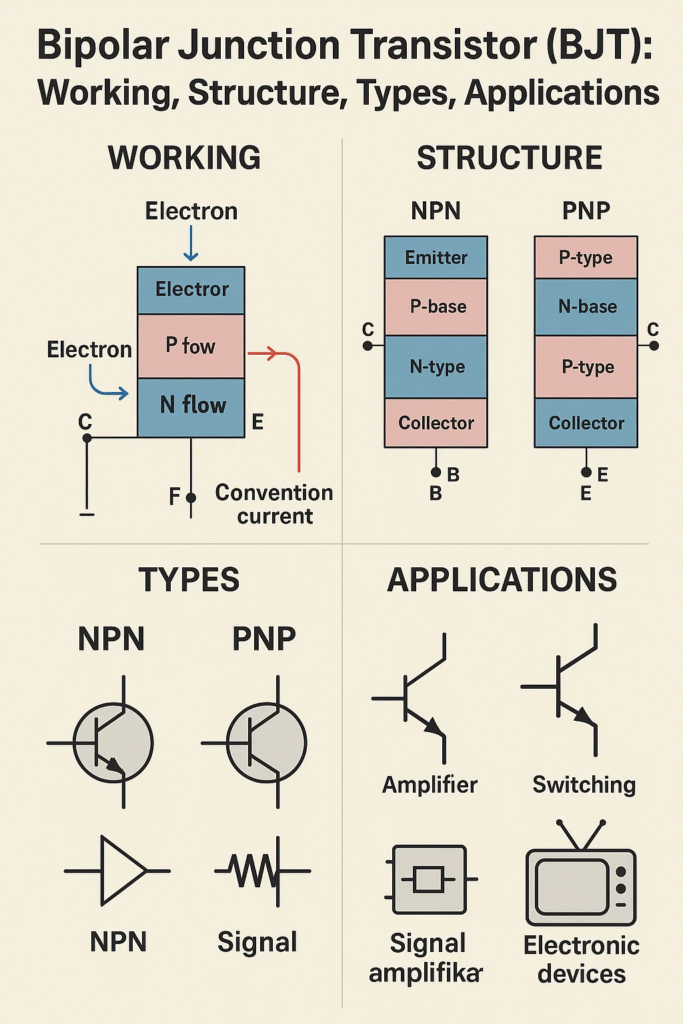Introduction
In the vast world of electronics, few components have had as profound an impact as the Bipolar Junction Transistor (BJT). From amplifying signals in radios to switching currents in computers, BJTs are the unsung heroes behind countless devices we use every day. Despite the rise of newer technologies like MOSFETs, BJTs remain relevant due to their unique properties and versatility.
This blog dives deep into the world of BJTs—exploring their structure, working principles, types, and real-world applications. Whether you’re a student, hobbyist, or engineer, this guide will help you understand BJTs in a clear and engaging way.
What Is a Bipolar Junction Transistor?
A Bipolar Junction Transistor (BJT) is a three-layer, three-terminal semiconductor device that can amplify or switch electrical signals. It’s called “bipolar” because it uses both electrons and holes as charge carriers.
Key Features
- Three terminals: Emitter, Base, Collector
- Two types: NPN and PNP
- Used for: Amplification, switching, signal modulation
BJTs are current-controlled devices, meaning the output current is controlled by the input current at the base terminal.
Structure of a BJT
BJTs are made by sandwiching three layers of semiconductor material. Depending on the arrangement, we get two types:
1. NPN Transistor
- Layers: N-type (Emitter), P-type (Base), N-type (Collector)
- Majority carriers: Electrons
- Most commonly used type
2. PNP Transistor
- Layers: P-type (Emitter), N-type (Base), P-type (Collector)
- Majority carriers: Holes
Terminal Functions
| Terminal | Function |
|---|---|
| Emitter | Emits charge carriers into the base |
| Base | Thin and lightly doped; controls the flow |
| Collector | Collects carriers from the base |
The base is extremely thin compared to the emitter and collector, allowing efficient carrier movement and amplification.
Working Principle of BJT
BJTs operate by controlling the flow of current between the collector and emitter using a small current at the base.
How It Works (NPN Example)
- Forward Bias: The base-emitter junction is forward biased, allowing electrons to flow from emitter to base.
- Reverse Bias: The base-collector junction is reverse biased, pulling electrons from the base into the collector.
- Amplification: A small base current controls a much larger collector current.
Current Relationships
- Collector Current (I_C) ≈ β × Base Current (I_B)
- Emitter Current (I_E) = I_C + I_B
Where β (beta) is the current gain, typically ranging from 20 to 200.
Modes of Operation
BJTs can operate in different modes depending on the biasing of the junctions:
| Mode | Base-Emitter | Base-Collector | Function |
|---|---|---|---|
| Active | Forward | Reverse | Amplification |
| Cut-off | Reverse | Reverse | OFF state |
| Saturation | Forward | Forward | ON state |
| Reverse-active | Reverse | Forward | Rarely used |
Types of BJTs
BJTs come in various types based on construction, packaging, and application.
1. Based on Polarity
- NPN Transistor: Most common, faster response
- PNP Transistor: Used in complementary circuits
2. Based on Packaging
- Through-hole BJTs: Used in prototyping and hobby projects
- Surface-mount BJTs: Used in compact, high-density circuits
3. Based on Power Rating
- Low-power BJTs: Used in signal processing
- High-power BJTs: Used in industrial applications
4. Based on Frequency Response
- General-purpose BJTs
- RF BJTs: Designed for high-frequency applications
Characteristics of BJTs
BJTs exhibit several important electrical characteristics:
1. Input Characteristics
- Relationship between base current and base-emitter voltage
- Non-linear due to diode-like behavior
2. Output Characteristics
- Relationship between collector current and collector-emitter voltage
- Shows saturation, active, and cut-off regions
3. Transfer Characteristics
- Relationship between collector current and base current
- Defines current gain (β)

Applications of BJTs
BJTs are incredibly versatile and used in a wide range of applications:
1. Amplifiers
- Audio Amplifiers: Boost sound signals
- RF Amplifiers: Used in radios and communication devices
- Operational Amplifiers: Core component in analog circuits
2. Switching Devices
- Digital Logic Circuits: ON/OFF control
- Relay Drivers: Control high-current devices
- Power Supplies: Regulate voltage and current
3. Oscillators
- Generate periodic signals
- Used in clocks, timers, and waveform generators
4. Signal Modulation
- Used in AM/FM transmitters
- Modulate carrier signals with data
5. Motor Control
- BJTs can switch and control motors in robotics and automation
6. Voltage Regulation
- Used in linear voltage regulators
- Maintain stable output voltage
Advantages of BJTs
- High gain and bandwidth
- Good linearity for analog applications
- Simple biasing and control
- Available in a wide range of specifications
Limitations of BJTs
- Lower input impedance compared to MOSFETs
- Higher power consumption
- Slower switching speed
Conclusion
The Bipolar Junction Transistor (BJT) is a cornerstone of modern electronics. Its ability to amplify and switch signals has made it indispensable across countless applications—from audio systems to industrial automation. Understanding its structure, working principles, and characteristics not only deepens your knowledge of electronics but also opens the door to designing more efficient and reliable circuits.
Despite the rise of newer technologies, BJTs continue to thrive in analog domains, educational labs, and legacy systems. Their simplicity, effectiveness, and versatility ensure they remain a vital part of the electronic landscape.
